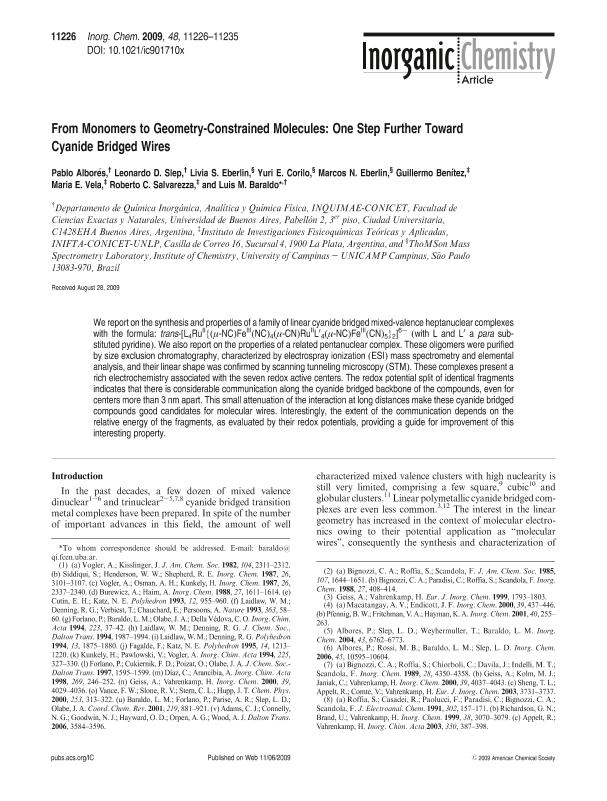Artículo
From monomers to geometry-constrained molecules: One step further toward cyanide bridged wires
Alborés, Pablo ; Slep, Leonardo Daniel
; Slep, Leonardo Daniel ; Eberlin, Livia S.; Corilo, Yuri E.; Eberlin, Marcos N.; Benitez, Guillermo Alfredo
; Eberlin, Livia S.; Corilo, Yuri E.; Eberlin, Marcos N.; Benitez, Guillermo Alfredo ; Vela, Maria E.; Salvarezza, Roberto Carlos
; Vela, Maria E.; Salvarezza, Roberto Carlos ; Baraldo Victorica, Luis Mario
; Baraldo Victorica, Luis Mario
 ; Slep, Leonardo Daniel
; Slep, Leonardo Daniel ; Eberlin, Livia S.; Corilo, Yuri E.; Eberlin, Marcos N.; Benitez, Guillermo Alfredo
; Eberlin, Livia S.; Corilo, Yuri E.; Eberlin, Marcos N.; Benitez, Guillermo Alfredo ; Vela, Maria E.; Salvarezza, Roberto Carlos
; Vela, Maria E.; Salvarezza, Roberto Carlos ; Baraldo Victorica, Luis Mario
; Baraldo Victorica, Luis Mario
Fecha de publicación:
12/2009
Editorial:
American Chemical Society
Revista:
Inorganic Chemistry
ISSN:
0020-1669
Idioma:
Inglés
Tipo de recurso:
Artículo publicado
Clasificación temática:
Resumen
We report on the synthesis and properties of a family of linear cyanide bridged mixed-valence heptanuclear complexes with the formula: trans-[L 4RuII{(μ-NC)FeIII(NC)4(μ-CN) RuIIL′4(μ-NC)FeIII(CN) 5}2]6- (with L and L′ a para substituted pyridine). We also report on the properties of a related pentanuclear complex. These oligomers were purified by size exclusion chromatography, characterized by electrospray ionization (ESI) mass spectrometry and elemental analysis, and their linear shape was confirmed by scanning tunneling microscopy (STM). These complexes present a rich electrochemistry associated with the seven redox active centers. The redox potential split of identical fragments indicates that there is considerable communication along the cyanide bridged backbone of the compounds, even for centers more than 3 nm apart. This small attenuation of the interaction at long distances make these cyanide bridged compounds good candidates for molecular wires. Interestingly, the extent of the communication depends on the relative energy of the fragments, as evaluated by their redox potentials, providing a guide for improvement of this interesting property.
Archivos asociados
Licencia
Identificadores
Colecciones
Articulos(INIFTA)
Articulos de INST.DE INV.FISICOQUIMICAS TEORICAS Y APLIC.
Articulos de INST.DE INV.FISICOQUIMICAS TEORICAS Y APLIC.
Articulos(INQUIMAE)
Articulos de INST.D/QUIM FIS D/L MATERIALES MEDIOAMB Y ENERGIA
Articulos de INST.D/QUIM FIS D/L MATERIALES MEDIOAMB Y ENERGIA
Citación
Alborés, Pablo; Slep, Leonardo Daniel; Eberlin, Livia S.; Corilo, Yuri E.; Eberlin, Marcos N.; et al.; From monomers to geometry-constrained molecules: One step further toward cyanide bridged wires; American Chemical Society; Inorganic Chemistry; 48; 23; 12-2009; 11226-11235
Compartir
Altmétricas



